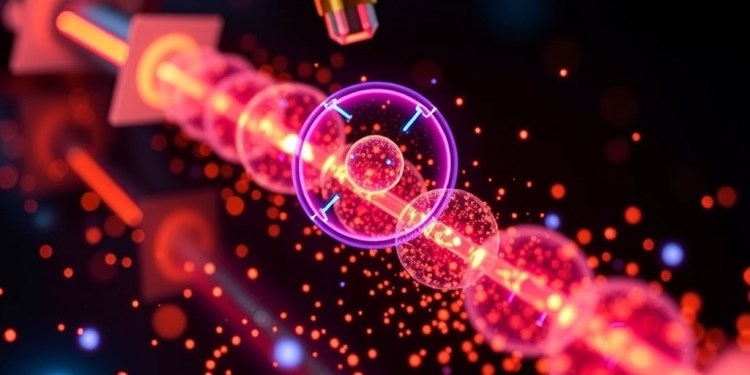As the world increasingly faces intricate challenges related to technology, energy, and environmental sustainability, the exploration of advanced materials gains more urgency and importance. Among the forefront of this research are nanomaterials, specifically quantum dots, which exhibit remarkable optical and electronic properties that render them transformative in various applications including solar energy conversion, LED technologies, medical imaging, and sensing devices.
Recent advancements by a dedicated team at the University of Liège (ULiège) have the potential to revolutionize how quantum dots are produced by introducing a sustainable production method that prioritizes environmental safety. The research focuses on cadmium chalcogenide quantum dots—known for their superior performance in optoelectronics—produced through an innovative aqueous process. This freshly developed method relies on a biocompatible chalcogenide source, utilizing water rather than traditional organic solvents, thereby significantly reducing the ecological impact of quantum dot manufacturing.
What sets this new approach apart is its design as a continuous flow process, which integrates efficiency with sustainability. This paradigm shift not only curtails energy consumption but also minimizes waste, showcasing a responsible path towards large-scale production of nanomaterials. The significance of this research extends beyond performance metrics; it embodies the commitment to aligning scientific innovation with the pressing need for environmentally responsible practices in material production.
The specific technique developed integrates a water-soluble chalcogenide source with a unique transfer agent, TCEP (tris(2-carboxyethyl)phosphine), that was originally known for peptide synthesis. Researchers recognized a unique opportunity to adapt this agent for a safer and more scalable chalcogen transfer method. The application of TCEP proves to be remarkably effective, paving the way for high-quality quantum dot synthesis without the hazardous byproducts typically associated with conventional methods.
Critically, the benefits of the new method also align with the growing regulatory framework concerning environmental sustainability and material toxicity. The use of cadmium-based quantum dots, although effective, raises significant health and environmental concerns due to the toxicity associated with cadmium. Thus, as part of their comprehensive study, the ULiège team is simultaneously investigating alternative materials that could replace cadmium without compromising on performance metrics. Their goal is to identify less toxic and more sustainable materials that adhere to the strict standards being adopted globally.
Collaboration was another cornerstone of this research, bringing together expertise from multiple laboratories within ULiège, including the Center for Integrated Technology and Organic Synthesis (CiTOS) and the Materials Science Laboratory (MSLab). The synergy between these distinct teams enabled the successful creation and testing of the new chalcogenide source. Furthermore, a noteworthy collaboration with spectroscopy expert Cédric Malherbe allowed the researchers to employ advanced analytical techniques, notably in situ Raman spectroscopy, which tracked the chemical pathways throughout the quantum dot synthesis process in real-time. This methodological innovation is pivotal as it provides unprecedented insights into the reaction mechanisms involved.
As the research unfolds, it opens a realistic and responsible pathway towards the industrial-scale production of nanomaterials. It not only promises efficiency and quality but also underscores the necessity of aligning scientific progress with principles of sustainability. The researchers at ULiège are setting a benchmark for future studies in nanomaterials, driving efforts away from merely optimizing performance to embracing holistic approaches that incorporate safety and environmental considerations.
Furthermore, the research findings being published in reputable journals such as Chemical Science and Materials Science and Engineering reflect the depth of inquiry and commitment to pushing the boundaries of current scientific understanding. The broader implications of this work extend beyond the laboratory, as they could potentially influence industrial practices and lead to a broader acceptance of sustainable technologies in consumer products.
In a world that increasingly values sustainability alongside technological advancement, the work being done at ULiège embodies a necessary shift in how we approach the synthesis and application of materials. The pressing need for innovations that marry efficiency with environmental consciousness may very well determine the trajectories of future technological developments. As this field continues to evolve, the commitment of researchers to explore greener alternatives will likely catalyze changes in regulatory standards and market expectations.
The journey toward sustainable quantum dot production illustrates a larger movement within the scientific community—one that prioritizes not only performance but also ethical considerations in research and material development. Ultimately, as more researchers follow the exemplary path set by the team at ULiège, the potential for transformative changes across industries grows significantly, promising a future where advanced materials are synonymous with sustainability.
This essential research captures the attention of the scientific community, and the implications of their findings resonate beyond the academic sphere, influencing policy and industry. The vision of producing high-quality, biocompatible quantum dots in an eco-friendly manner sets a new standard in the materials science realm, demonstrating that scientific innovation can thrive within sustainable frameworks.
Collectively, the implications of these advancements serve to inspire future researchers and steer discussions about the role of innovation in addressing global challenges. As industries adapt and respond to these emerging strategies, there is a real opportunity to reshape how materials are perceived, produced, and utilized, ultimately contributing to a more sustainable future for all.
Subject of Research: Quantum Dots Production
Article Title: Towards sustainable quantum dots: Regulatory framework, toxicity and emerging strategies
News Publication Date: 2-Apr-2025
Web References: DOI
References: Not applicable
Image Credits: Not applicable
Keywords
Nanomaterials, quantum dots, sustainability, cadmium chalcogenide, biocompatible, eco-friendly, spectroscopy, materials science, energy consumption, green chemistry, regulatory framework, toxicology.
Tags: advanced materials researchbiocompatible chalcogenide sourcescadmium chalcogenide quantum dotscontinuous flow production techniqueseco-friendly nanomaterialsenvironmental impact of manufacturingminimizing waste in productionoptoelectronic devicesquantum dot manufacturingrenewable energy applicationssustainable quantum dot synthesisUniversity of Liège research advancements





